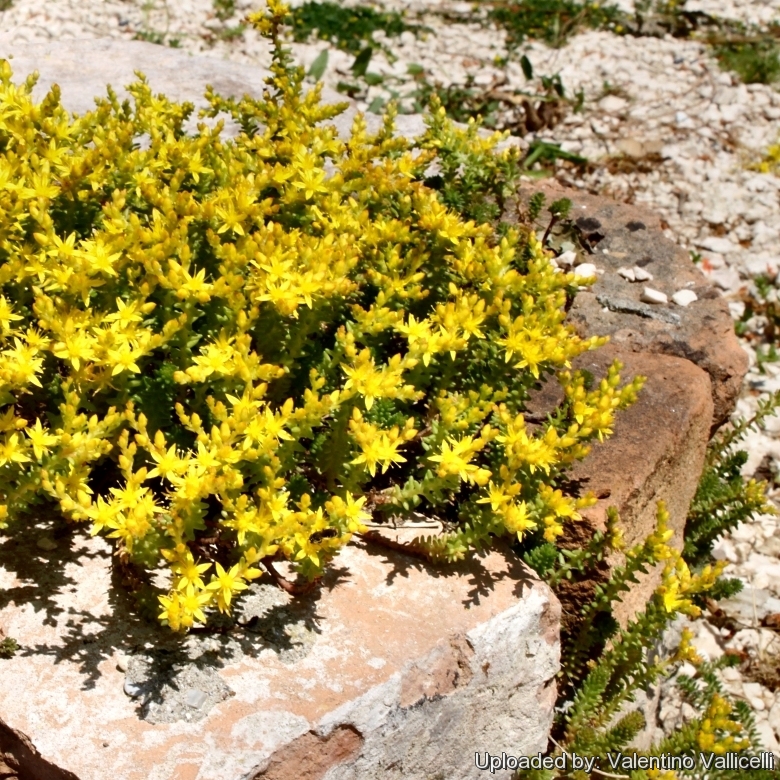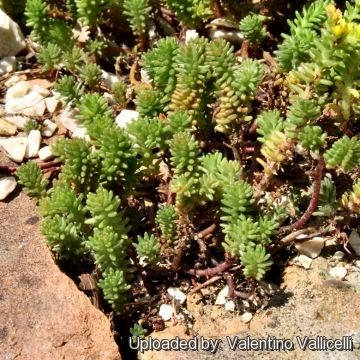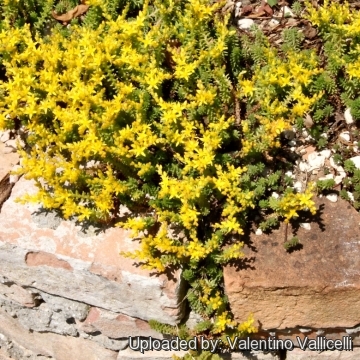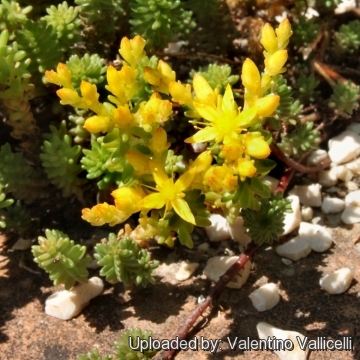
Sedum sexangulare Photo by: Valentino Vallicelli
Origin and Habitat: South, eastern and central Europe and adjacent Asia. Sedum sexangulareSN|19455]]SN|19455]] is cultivated, and often escape to nearly disturbed areas. This species has been introduced to North America and in other temperate countries.
Habitat: Forms carpets on rocky outcrops, sandy dry grasslands, dry pine forests, railways, bare banks, walls and other dry places in any soil.
Synonyms:
See all synonyms of Sedum sexangulare
back
Accepted name in llifle Database:Sedum sexangulare L.Sp. Pl. 1: 432. 1753 [1 May 1753]Synonymy: 18
back
Common Names include:
ENGLISH: Tasteless Stonecrop, Chain Stonecrop, Stonecrop, Insipid Stonecrop, Six-sided Stonecrop, Watch-chain Sedum
Description: Sedum sexangulareSN|19404]]SN|19455]] commonly known as the “Six angled stone crop” has dark green leaves arranged in six longitudinal, spiralled rows. Its yellow flowers appear bunched at the stem-tip in June to July .
Note: Sedum sexanuglare frequently occurs in close association with the similar Sedum acre (Common Stonecrop ), and by some considered a mere variety of it. Although both species quite often even grow intermingled they need not be confused. Sedum sexanuglare differs for the more slender leaves, several times longer than thick, and by the flavour said to be less acrid.
Habit: It is a small, evergreen perennial succulent that forms mats 5-15 cm tall and up to 50 cm (or more) in diameter.
Root: Has perennial fibrous roots.
Stem: Thick, short, succulent branching at the base.
Leaves: Small, sessile, gibbous, suboval to sub-cylindrical (sausage shaped) , erect to about 3-7 mm long and about 1,5 mm wide, dark green, close together, 3 (or 4) in a whorl, on barren branches, imbricated in the shoots in 6 (at times 7) longitudinal, spiralled rows, those on the flowering-stems usually in threes. Leaves are longer, more numerous, and usually much redder than those of Sedun acre.
Inflorescences: Terminal cymes born on leafy erect stems, 3 cut, formed by 2 larger branches and a small one.
Flowers: Hermaphrodite, mostly 5-merous (five petaled), starry (radially symmetrical), yellow, much like those of Sedum acre, or rather paler and smaller. Petals lance-shaped, taper-pointed 4-5 (rarely 6) mm wide. Stamens in 2 circles, each provided with the same number as the petals. The ovaries are free.
Blooming season: Its yellow flowers appear in early summer (in northern hemisphere June to August), usually rather later than Sedum acreSN|19455]]SN|19404]].
Chromosome number: 2n = 74
Bibliography: Major references and further lectures
1)James Sowerby, Sir James Edward Smith, George Shaw “English Botany; Or, Coloured Figures of British Plants, with Their Essential Characters, Synonyms, and Places of Growth: To which Will be Added, Occasional Remarks”, Volume 6 1807
2) Harrison L. Flint “Landscape Plants for Eastern North America: Exclusive of Florida and the Immediate Gulf Coast” John Wiley & Sons, 09/apr/1997
3) Samuel Frederick Gray “A Natural Arrangement of British Plants: According to Their Relations to Each Other as Pointed Out by Jussieu, De Candolle, Brown, &c. ...” Baldwin, Cradock, and Joy, 1821
4) “Encyclopaedia Perthensis; or, Universal dictionary of Knowledge.” Encyclopaedia Perthensis 1816
5) William Robinson “Hardy Flowers” Applewood Books, 01/gen/2009
6) Stephen Robson “The British Flora: Containing the Select Names, Characters, Places of Growth, Duration, and Time of Flowering of the Plants Growing Wild in Great Britain : to which are Prefixed the Principles of Botany “ W. Blanchard, 1777
7) Gwen Moore Kelaidis “Hardy Succulents: Tough Plants for Every Climate” Storey Publishing, 01/mar/2012
8) Stephenson, Ray “Sedum.” Timber Press. 1994
9) Otto Schmeil, Jost Fitschen, Siegmund Seybold “Flora von Deutschland und angrenzender Länder.” 93 Edition Quelle und Meyer Verlag, Wiebelsheim 2006
10) Eckehart J. Jäger, Friedrich Ebel, Peter Hanelt, Gerd K. Müller (Hrsg.) “Rothmaler Exkursionsflora von Deutschland, Band 5: Krautige Zier- und Nutzpflanzen.” Spektrum Akademischer Verlag, Berlin Heidelberg 2008
11) Wolfgang Lippert “Crassulaceae” In Gustav Hegi: “Illustrierte Flora von Mitteleuropa.” Blackwell-Wissenschaftsverlag Berlin 1995.
12) James Cullen, Sabina G. Knees, H. Suzanne Cubey “The European Garden Flora Flowering Plants: A Manual for the Identification of Plants Cultivated in Europe, Both Out-of-Doors and Under Glass” Cambridge University Press, 11/ago/2011
13) Jaakko Jalas, Juha Suominen, Raino Lampinen, Arto Kurtto “Atlas florae europaeae.” volume 12 (Resedaceae to Platanaceae). Helsinki 1999
 Sedum sexangulare Photo by: Valentino Vallicelli
Sedum sexangulare Photo by: Valentino Vallicelli Sedum sexangulare Photo by: Valentino Vallicelli
Sedum sexangulare Photo by: Valentino Vallicelli Sedum sexangulare Photo by: Valentino Vallicelli
Sedum sexangulare Photo by: Valentino Vallicelli Sedum sexangulare Photo by: Valentino Vallicelli
Sedum sexangulare Photo by: Valentino VallicelliCultivation and Propagation: Always an interesting plant and very easy to grow in container or in the rock garden. It is incredibly tough, sun and drought tolerant, but also will do well in shade.
Soil: Require a well drained succulent soil mix. Outdoors it will spread itself through narrow locations between rockery stones. It does not prefer rich loamy soil; gritty dirt with pea gravel suits it.
Wateing: It takes little water & could rot if watered too often. During the growing season, the plants are watered and allowed to dry slightly before watering again. Although they can take a great deal of drought, they seem to do better with regular (but moderated) watering and it is best to refrain from watering it until the rootball has dried out completely. During the winter months, plants are watered very little. Its succulent leaves will store enough water to survive for long time.
Exposition: It need full sun to light shade and tolerates shade, but a sunny spot is nicest, though in warmer climates it needs protection from too much sun because it is not very heat tolerant.
Frost Tolerance: Hardy at least to -12°C (or less).
Uses: This Sedum can form a carpet that drapes over stones or walls. Outdoors on rock crevices with favourable water regime, eastern slopes alpine house, poor, drained soil, shading in summer. This species along with Sedum sexangulareSN|19404]]SN|19455]], Sedum anglicum, Sedum lydium, Sedum acreSN|19455]]SN|19404]], and others can be a nuisance among choice perennials, where every tiny leaflet that breaks off quickly forms a new plant. Also a good choice for tubs and mixed containers. Excellent choice for a children’s garden. Good winter effect, developing a bronzy-green colour. This Sedum can take occasional foot traffic and doesn't require a lot of water.
Propagation: This is a tough plant which spreads aggressively, division of old plant can be made in spring and late summer; cuttings in summer.














